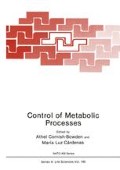Abstract
The general aim of flux control analysis (Kacser & Bums, 1973; Heinrich & Rapoport, 1974) is to determine control distribution of a certain metabolic process among its different steps in vivo, for given physiological conditions. The relative importance of each step (enzyme or carrier) is quantified by its control coefficient, which expresses the fractional change produced in the selected flux, as a consequence of an infinitesimal fractional change in the enzyme activity. To obtain quantitative values of these control coefficients, experimental access to flux assay and modulation of enzyme activity are necessary. Normally these two requirements pose certain problems that are difficult to solve. In vivo, flux measurement is often not easy as all metabolic processes are interconnected. Usually, only in the processes that produce a metabolic end product, such as CO2 or urea, or absorb an external substrate, such as glucose or amino acids, can flux in vivo be easily measured. The problem can become simplified in unicellular organisms, as their metabolic interactions are obviously simpler, but in any case nobody thinks that control analysis should be restricted to this type of organism. Even in the cases where the metabolic pathway implies a waste end-product or an external precursor, control analysis obliges us to define a precise metabolic pathway (which can involve branching) defined by one or several “external” substrates and products. The definition of these limits of the metabolic system is arbitrary (examples: glycolysis, pentose phosphate pathway, Krebs cycle etc). Therefore, the problem is not only the flux assay in vivo, but the delimitation of the metabolic pathway and the way of managing its function in vivo experimentally as well, a problem that is aggravated by the complexity of both organisms and metabolic pathways. The other problem is to obtain the modulation in vivo of all the enzymes (or at least some of them) implicated in the process. This can be done through genetic modulation or by means of specific inhibitors, but these two methods cannot always be used. However, if we transfer our problems to the field of experimentation in vitro, many of the problems mentioned can be solved. The method described here deals with the use of systems in vitro to study the distribution of control in metabolic pathways. We describe the general principles of application, which are based on familiar concepts and procedures of classical enzymology, although used to control analysis in whole systems. We shall give a general design and criticize its different features, in order to comment on the possibilities of its application to different types of systems. The method was first described by us (Tones et al., 1985) and subsequently applied by our group to the control distribution in the first steps of rat-liver glycolysis under different physiological conditions (Mateo et al., 1989; Tones et al., 1988ab). Furthermore, on the basis of this method, a practical exercise has been proposed for initiating students in control analysis (Torres et al., 1988c).
Access this chapter
Tax calculation will be finalised at checkout
Purchases are for personal use only
Preview
Unable to display preview. Download preview PDF.
References
Groen, A. K., Wanders, R. J. A., Westerhoff, H. V., van der Meer, R. and Tager, J. M. (1982) J. Biol. Chem. 257, 2754–2757
Heinrich, R. and Rapoport, T. A. (1974) Eur. J. Biochem. 42, 89–95
Kacser, H. and Burns, J. A. (1973) Symp. Soc. Exp. Biol. 27, 65–104
Mateo, F., Torres, N. V. and Meléndez-Hevia, E. (1989) Cell. Molec. Biol. 35, 33–37
Meléndez-Hevia, E., Siverio, J. M. and Pérez, J. A. (1984) 1nt. J. Biochem 16,469–476
Meléndez-Hevia, E., Torres, N. V., Sicilia, J. and Kacser, H. (1990) Biochem. J. 265, 195–202
Salter, M., Knowles, R. and Pogson, C. I. (1986) Biochem. J. 234, 635–647
Torres, N. V. (1985) Doctoral Thesis, Universidad de La Laguna
Torres, N. V., Mateo, F., Meléndez-Hevia, E. and Kacser, H. (1986) Biochem. J. 234, 169–174
Torres, N. V., Mateo, F., Sicilia, J. and Meléndez-Hevia, E. (1988a)Int.J. Biochem. 20,161–165
Torres, N. V., Mateo, F. and Meléndez-Hevia, E. (1988b)FEBS Lett. 233, 83–86
Torres, N. V., Meléndez-Hevia, E. and Riol-Cimas, J. M. (1988c)Biochem. Educ. 16,100–102
Torres, N. V., Souto, R. and Meléndez-Hevia, E. (1989) Biochem. J. 260, 763–769
Author information
Authors and Affiliations
Editor information
Editors and Affiliations
Rights and permissions
Copyright information
© 1990 Springer Science+Business Media New York
About this chapter
Cite this chapter
Meléndez-Hevia, E., Torres, N.V. (1990). Determination of Control Coefficients by Shortening and Enzyme Titration of Metabolic Pathways. In: Cornish-Bowden, A., Cárdenas, M.L. (eds) Control of Metabolic Processes. NATO ASI Series, vol 190. Springer, Boston, MA. https://doi.org/10.1007/978-1-4757-9856-2_19
Download citation
DOI: https://doi.org/10.1007/978-1-4757-9856-2_19
Publisher Name: Springer, Boston, MA
Print ISBN: 978-1-4757-9858-6
Online ISBN: 978-1-4757-9856-2
eBook Packages: Springer Book Archive

